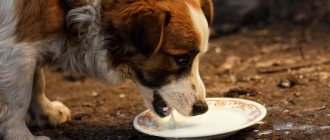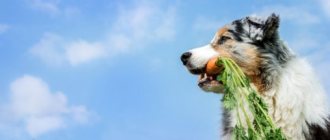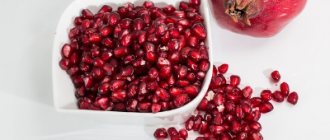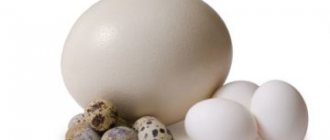Since wild dogs and cats began to be tamed by humans, their behavior, daily routine, reflexes, habits have changed a lot.
Domesticated animals that live in “greenhouse conditions” can be classified as a separate biological species . The conditions created by man are contrary to those dictated by the environment in the process of evolution.
There is an opinion that porridge should not be present in the diet of dogs, as it disrupts the intestinal microflora and can cause allergies. But we are not talking about domestic dogs whose owners feed them human food. Let's look at the issue from opposite points of view.
Buckwheat porridge
According to experts, buckwheat is for animals. It contains vitamins (A, B, E, H, PP), minerals (iron, calcium, zinc, magnesium, etc.), fiber, complex carbohydrates, amino acids.
Buckwheat saturates the body, fills it with vigor and energy.
The value of buckwheat lies in accelerating metabolism, stabilizing the cardiovascular system, strengthening the immune system and bone tissue. Thanks to its unique composition, buckwheat allows the body to rehabilitate faster in the postoperative period. Thanks to it, the dog does not gain weight, and also forgets about what allergies are.
Buckwheat porridge is considered the best option for a pet, but it must be prepared correctly. Here is the method recommended by veterinarians: pour 1 cup of buckwheat into 2 cups of boiling water. Cover the pan with a lid and wrap it in a blanket. Leave overnight. The next morning the porridge is ready to eat. Since most of the beneficial substances are lost during heat treatment, there is no need to cook the dish, nor do you need to add salt and pepper.
Rice porridge
Rice is enriched with vitamins B, E, magnesium, calcium, zinc, iron, copper and other minerals, lipids. Cereals are a natural antioxidant and adsorbent and cleanse the body of toxins. That is why it is recommended for dogs that have previously been diagnosed with poisoning. In addition, it is endowed with astringent properties, so it is useful for animals with diarrhea.
Rice porridge gently envelops the stomach and reduces pain, so pets suffering from inflammatory processes in the digestive tract should definitely eat this dish.
However, rice also has contraindications. Due to its high starch content, it can be harmful to dogs with diabetes, obesity, and diarrhea. This does not mean that rice porridge is prohibited for such patients, it just needs to be given occasionally, to diversify the diet.
Preference should be given to unpolished rice, since it contains less starch than polished rice and more vegetable protein.
Method of preparation: rinse the cereal, soak it for an hour and a half in cold water. Soaking unpolished rice - 20 minutes. Boil. If the porridge turns out to be thick, you can add a little vegetable oil.
Oats
Oats and rolled oats should not be confused. Oats are whole grains, while rolled oats are flattened grains. However, both cereals are very useful for your pet. They contain vitamins A, B, E, PP, minerals (calcium, potassium, magnesium, sodium, etc.), vegetable proteins, amino acids, fats.
Diet porridge is an indispensable product for normalizing digestion after an illness accompanied by vomiting and diarrhea, or prolonged fasting. Gluten delicately envelops the intestines and walls of the digestive tract, and has a beneficial effect on the stomach and pancreas during inflammation. Oatmeal and jelly are always recommended by nutritionists for animals with gastritis and enteritis.
Do not forget: oatmeal can cause allergies and digestive upset. If you are giving oatmeal for the first time, add it in small quantities to the main dish to check whether it will become an allergen for your pet, and observe for a day. If your dog does not have an allergic reaction to oatmeal, include it in the diet, but do not overuse it.
It is advisable to give preference to oats other than oatmeal. It takes longer to cook, but it contains more nutrients. To prepare the grains, soak them in cold water for 2-3 hours, then boil them without adding salt. With soaking, the cereal will cook in 40-50 minutes.
In what form can corn be included in the diet?
Corn flakes (sticks), as well as popcorn, contain gluten, which is not digested by dogs, so these products should not be used to feed your pet.
If you want to pamper your furry pet with a treat, you need to remember that:
- When making popcorn, heat treatment is used, so the product will not be beneficial;
- Excessive consumption may cause indigestion;
- solid particles cause injury to the jaw and the development of inflammatory processes;
- Flakes and sticks contain a lot of sugar, which negatively affects vision.
Many dog breeders know that their pets love to chew on raw corn on the cob. In this case, the following happens:
- When grains enter the stomach, they greatly increase in volume.
- Undigested particles moving through the digestive tract can cause intestinal blockage.
Constipation that occurs in this case is the most minimal harm. This condition can cause intestinal volvulus, which is often fatal.
Sometimes dogs choke on the cob, so in order to protect your pet from possible problems, you should not give the product fresh.
Canned
Canned corn should also be excluded from the diet. This is explained by the fact that vinegar, salt, various spices and sugar are used to prepare it.
Boiled corn
Boiled corn, like oven-cooked corn, is safer than raw corn, but it is also not completely digestible. It makes no sense to include it in your diet.
Semolina
Semolina, like millet, is an absolutely useless product for dogs. Semolina contains no useful substances, but a lot of simple carbohydrates.
However, the doctor may recommend it to premature newborn puppies to gain weight or to animals with gastrointestinal inflammation (for the period of treatment, so as not to burden the stomach and intestines).
Semolina is contraindicated for dogs that are overweight, prone to obesity, sedentary individuals and animals with diabetes (cereals contribute to an increase in blood sugar levels).
In what quantities and how often should I give?
Rice porridge should not be given daily. Optimal rate: 2-3 times a week. Experts recommend alternating it with other cereals (buckwheat, millet, oatmeal) or cooking combined porridge (from several cereals at once).
As for the number of servings, it all depends solely on the size and weight of the dog. So, when feeding small breeds (toy terrier, Pekingese, pug, etc.), you should limit yourself to 100-150 g portions. For large dogs (German Shepherd, Labrador, etc.), the serving size can be increased by 2-3 times.
Attention! Dogs that are overweight or prone to obesity should be given the product as rarely as possible (this only applies to white polished cereal).
Barley porridge
Despite the fact that this cereal is very nutritious and enriched with vitamins, micro- and macroelements (fluorine, silicon), it is not suitable for daily use. The fact is that it is poorly absorbed by the body. Nevertheless, it must be given. For it to really bring benefits, it is better to mix it with other porridges, for example, with buckwheat.
Tip: feed your pet only freshly cooked porridge, after cooling it to room temperature. A cold dish turns into an unappetizing mess and is not absorbed by the body.
With milk or water?
Cooking semolina with milk is only allowed for feeding puppies. The fact is that milk contains a lot of lactose, which is easily digestible only by puppies; Adults run the risk of getting various problems with the gastrointestinal tract.
It is preferable to cook any porridge for a dog in water or broth, but when using meat, it is advisable to throw it into the prepared porridge. Also, it should not be too liquid or thick.
Important! In no case should you add salt or sugar - the dog gets them in the required quantities from other products (subject to a complete balanced diet), and an overdose of these substances will lead to extremely negative consequences, even death.
How to cook?
In order to properly prepare semolina for a dog, you will need:
- semolina – 250 g;
- water – 2 l;
- meat/minced meat/offal – 250 g.
Boil water, then slowly add the cereal, stirring constantly. Cut the meat into small pieces, add to the porridge and cook for about 5-7 minutes, stirring occasionally. Meat can be used either raw or lightly boiled, with the exception of pork - it must be well cooked before adding.
Corn porridge
Regarding whether it is possible to give a dog corn porridge, veterinarians agree: no, it is not! Just like millet and semolina, corn is completely useless for animals. Undoubtedly, it quenches the appetite well and gives a feeling of satiety, but it does not provide any nutritional value. But it's not only that.
Porridge passes through the gastrointestinal tract very difficultly, forms clumps and is poorly digested. In dogs that lead an active lifestyle, it can cause volvulus, a dangerous pathology. Under no circumstances should you give corn porridge to animals experiencing digestive problems, otherwise exacerbations cannot be avoided.
It is much more useful to offer the dog to chew on a fresh corn cob, but you need to make sure that he does not get carried away and get to the core. Don't be alarmed if the grains come out undigested in your feces.
How to cook corn porridge for a dog?
Of all the forms of the product, it is best to give your dog corn porridge. The principles of preparing food for animals are the same as for people:
- The cooking time should be calculated taking into account the grinding of the grain. The larger it is, the more time is spent on cooking.
- Before cooking, the cereal is washed well.
- Pour into boiling water (it is advisable to use a pan with thick walls).
- The porridge is cooked over low heat for about an hour, after cooking it is left to infuse in a warm place for 20-30 minutes.
- It is better to make the porridge semi-liquid; for this, a 4:1 proportion of liquid and cereal is used.
The dog is boiled corn porridge in water; after 6 months the milk is not absorbed by the pet’s body and causes diarrhea. To improve the taste, you can add butter to the dish.
You can also cook the porridge in the mild broth left over from cooking the meat. The dish is a side dish and should make up no more than 20% of the total daily food intake. The porridge is mixed with meat. A mandatory addition is vegetables. It is a source of fiber and slow carbohydrates; pumpkin, zucchini and carrots are best. Do not give your pets potatoes, tomatoes, or cucumbers. It is better to refuse exotic products.
What to add to porridge
As mentioned above, salt and spices should not be added to porridge. And excess fats will not be beneficial for your pet. However, you won’t be satisfied with porridge alone, so add meat and vegetables to it.
Vegetables are rich in fiber, which is beneficial for intestinal motility. Carrots, beets, rutabaga, pumpkin, and zucchini are most suitable for this purpose. You can give broccoli, cauliflower, and potatoes with caution. But you can’t give onions and garlic.
As for meat, the ideal option is turkey and rabbit, veal, horse meat. These are lean meats that will not harm the liver and are hypoallergenic.
Pork and lamb are too fatty, so they should be excluded from the menu.
Chicken is a dietary product, but it can cause allergies. Meat products must be subjected to heat treatment; frozen meat is also allowed.
By-products are very useful. The liver is a source of vitamins and micro- and macroelements; the heart, rumen, and lungs are good in this regard. They should be included in the diet boiled, as offal can be contaminated with helminths.











